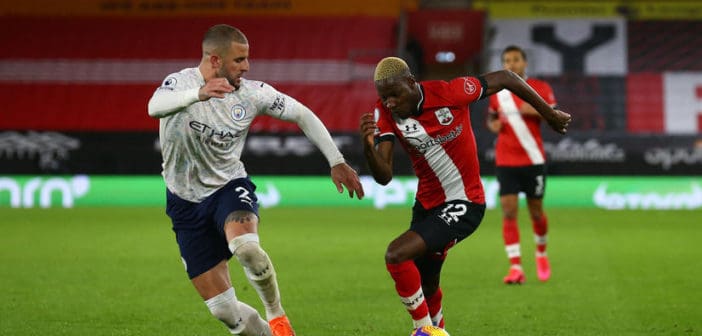As you’ll find in most walks of life, taking a shortcut or two is not always possible.
Going from A to B is ever-hardly straightforward, nor does it often conjure up the intended result you initially wanted. But for Southampton and in their own version of events, that’s exactly what they expect to do. And for the most part, their bludgeoning manner proves highly effective.
If you ever opened up the Ralph Hasenhuttl playbook, one of the opening chapters would surely detail his unrelenting love for heavy duty football. Below the bold italic caption would explain the intense emphasis placed upon passing incision and suffocating the spine of an opposition.
When Southampton’s oscillating rhythm ramps up to its highest gear, they immediately endeavour to play through lines and carve the other team open with ferocious speed but with effortless difficulty. It is all done very quickly and very violently, simply overwhelming opponents with the sheer amount of numbers pressing forward into one area.
If the various automatisms are executed to perfection, the ball is likely to be perpetually funnelled into central areas of the pitch. This is notably down to a Hasenhuttl core principle of utilising the ‘red zone’ as the primary source of creation. The narrow configuration of the manager’s 4-2-2-2 system means there is a heavy emphasis of ball possession centrally.
In this moment in time, the Austrian continues to add different complexions and facets to this burgeoning Southampton side. But taking detours or simple shortcuts cannot be possible in every game, especially in ones against teams that negate your strengths and illuminate your shortcomings. If Saints are going to reach their preferred destination come the end of the season, they will need to keep evolving.
To find the answer to these quandaries, you might have to take a look out-wide.
Saturday’s match against Manchester City exposed a particular dependency in extracting goalscoring chances through the core of the team.
Pep Guardiola’s decision to opt for a double pivot in Ilkay Gundogan and Rodri meant Saints had an extra body to play through if they were to reach their desired destination – playing passes into the red zone with any regularity. But City’s extra midfielder not only swamped an already log-jammed midfield, it also offset a vital aspect within Southampton’s production line.
In the second half, Guardiola tweaked the structure and plumped for a varaition to Hasenhuttl’s very own 4-2-2-2 system. Bernardo Silva and Kevin De Bruyne operated as false nines, allowing City to close ranks centrally with even more purpose and successfully filter Saints’ attacks into wide areas.
While the host’s right-hand side looked particularly impressive with Kyle Walker-Peters and Theo Walcott overloading the moonlighted left-back Joao Cancelo and the diagonal balls of Jannik Vestergaard continuing to be a form of artistry, the opposing flank wasn’t quite as potent.
The lack of dynamism and partnership between Ryan Bertrand and Moussa Djenepo meant the slant of Southampton’s attacks were becoming increasingly lopsided and predictable.
The instance taken from the second half illustrates the struggle Southampton faced all afternoon and how content Manchester City were in letting the ball go into wide areas, smothering any passes into the red zone. When Rodri goes to press Romeu, Gunodgan is stationed in a covering position. This cuts off any pass forward if Rodri is not initially successful in regaining possession.
Note how narrow City’s back four is, barely extending past the width of the 18-yard-box.

As a match against Pep Guardiola so often presents, Southampton will have accrued plenty of lessons and positives from the weekend’s defeat. Varying the angle in which the thrust of their bayonet attacks from may just sit at the top of the ‘lessons learnt’ list.
Manchester City shed the greatest light on this area of Southampton’s game. However, evidence suggests other teams have cottoned onto it, too.
Take the 1-1 draw against Wolves in November. It was the first time in Nuno Espírito Santo’s three-year tenure that he had adopted a four man defence. A player less in the backline meant a player more in the midfield and an extra pair of legs to help contend with Southampton’s tendency to overload numbers centrally.
The example below is taken from the first half and is a pertinent example of Espírito Santo’s shift in approach proving fruitful. Saints are in comfortable possession and Jan Bednarek is on the ball. The centre-back is looking to play through the Wolves midfield and into Stuart Armstrong, who has glided in from the right and into the red zone.
Again, consider the narrow nature of Wolves’ two banks – both sets of full-backs and wingers are well inside the 18-yard-box. With Ruben Neves screening the forward pass, Bednarek is forced to play sideways into Oriol Romeu.

Wolves’ narrow system and extra man in midfield means Southampton cannot play through the lines easily
In the same game, Wolves recognise Southampton’s lack of threat when switching play. A case in point is below, where the midfield four have all shifted across to overload the visitor’s right hand side. This not only continues to stop Armstrong from receiving, but underlines how comfortable Wolves are that they are willing to let all four of their midfielders shift to one side of the pitch.
They can afford to take this type of risk knowing Southampton haven’t got the velocity to punish the exposed space if a switch of play does transpire.

Southampton are comfortable going backwards and recycling the ball through the back four, but the next forward pass tends to go inwards
In the following game against Manchester United, Ole Gunnar Solsjkaer may have heeded Wolves’ slight tactical nuance. United’s diamond swamped the Saints midfield and used their own strengths against them. With Bruno Fernandes dropping into the false nine role, Donny Van de Beek and Fred ether side of him and Nemanja Matic sat at the base, they drowned the middle of the park with bodies and forced Southampton to play into wide areas and most notably, Moussa Djenepo.
Southampton’s number 10’s have long crystallised Hasenhuttl’s footballing methodology, where vertical passes and dissections through the lines is optimal. Most of the time, against lesser footballing teams and lesser managerial acumen, the results are favourable. However, due to the saturated market of tactical analysis where any club can collate data in rapid time, it is likely Saints will be regularly posed this challenge in the future.
The answer? An intangible mix of imagination and combinations.
If Southampton can increase their enterprise on both flanks, it may mean opposition teams will feel vulnerable from all angles of attack, as opposed to just centrally. Sometimes a number 10 hugging the touchline and perhaps finishing the game with white paint on his boots, wouldn’t be such a bad thing. Though Hasenhuttl richly implores them to drift in from the wings, the occasional tendency to stay out the way in order to hold width could prove advantageous.
It is a more patient, less-in-your-face approach compared to the thudding petition of playing centrally, but the subtlety could work in their favour.
In turn, it may allow the full backs to underlap/overlap or give their fellow number 10 much sought-after room to weave in and out of the red zone and in-between the lines.
Glimpses of this was on show against Sheffield United, where rhythmic patterns and rotations from players closest to the touchline hinted at promising signs. Subsequently, it was no surprise to witness Southampton derive joy through numerical overloads out-wide.
#SaintsFC displaying the most fluid formation I've ever seen from
Armstrong moonlighting as a LW, LB and RM in first half.
Bertrand playing LCM and LCB
Ings playing across the front four positions.
Hasenhuttl's adding layers upon layers to this team.
— Jacob Tanswell (@J_Tanswell) December 13, 2020
Of course, rotations and an array of offensive patterns can only have the desired effect if there is fresh impetus from the players operating in those areas. Establishing connections between full-backs and the inverted wingers are key and more importantly, having the absolute confidence to carry out the actions with full vigour.
Crossing statistics accentuate the argument that Southampton do not make use of width the most effectively. At the time of writing, Hasenhuttl’s side are 17th for crosses attempted, with 202 coming in the 14 games played. Although they have shown they are proficient at coaxing opposition onto them before exploiting the vacated space, they do not use wide areas with any real directness or purpose to garner goalscoring chances.
A frank consequence of this is the scarcity of goals scored from fast breaks this season. Only they and Burnley are without a goal via this method of attack. Analysis suggests this can be attributed to adept wing play proving conducive routes in successful counter-attacks. Manchester United, now almost exclusively known as a notorious counter-attacking side, have scored five via this modus operandi.
Underlaps, overlaps, auxiliary dare in wing-play. All three would add yet another layer to Ralph Hasenhuttl’s multi-faceted, flourishing team.
In fairness, it should be regarded as a feather in Southampton’s cap that top-end teams are beginning to adjust their own tactical system to accommodate Saints’ strengths.
Hasenhuttl is a perfectionist, whose holistic approach to coaching will understand the continual need to smooth out any crinkles within the system. Improving wide play may just well sit at the top of the list.
Follow us on Twitter @ProstInt
![Prost International [PINT]](https://prostinternational.com/wp-content/uploads/2021/08/PINTtFontLogoRoboto1536x78.jpg)



